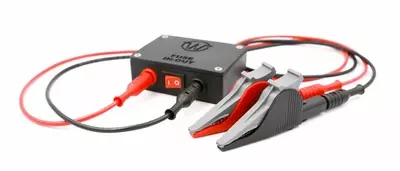WCDT Current Drain Tester - Parasitic Drain
Product Code: WCDT
Warwick Test Supplies Current Drain Tester - Battery Diagnostics The Current Drain Tester has been specifically designed to assist a technician with a Battery Parasitic Current Drain test. The purpose of the test is to assess and analyse the level of parasitic current drain from a vehicles' battery during its shutdown and sleep periods. The WCDT is manufactured in the UK using quality IEC61010 components and offers durable performance for the vehicle workshop environment. The WCDT Kit Features: A test box that has mounted banana plugs and sockets enabling you to make quick, reliable and repeatable connections to a multimeter, oscilloscope and test leads. The box also contains a fast acting 15A 600V 'meter saver' fuse for continual protection of your test instrument and a switchable 15A automotive link fuse enabling a quick check on first connection and the ability to disconnect your instrument without disturbing the vehicles' electrical system. A set of 1m black and red banana plug leads (longer lengths available).
A set of black and a red 36A 1000V large jaw crocodile clips.
Analysing the status of a vehicles' battery is a common procedure to assess the engine start-up function and also determine the working health of the charging system. Battery diagnostics enables accurate fault finding and helps identify a potential component failure (e.g starter motor or alternator). If the engine start-up and charging system are tested and both deemed fully functional, yet the engine start-up issues continue then investigation into battery Parasitic Current Drain is the next step.
Parasitic Current Drain can be defined as any electrical device that draws electric current when the ignition key is turned off. As technology installed in new vehicles continues to develop, the demand on power required from the vehicles battery also increases. The understanding and diagnosis of Parasitic Current Drain is a basic task that can be made overly difficult with the use of insufficient or poor test equipment. Vehicle technology is likely to continue to advance and the Current Drain Tester Kit will ensure technicians are able to perform Parasitic Current Drain tests across all vehicles with improved speed and accuracy.
Voltage drop values are commonly measured with an Automotive Digital Multimeter and Parasitic Current Drain is commonly monitored on an Oscilloscope. A Low Amp Current Clamp can monitor the various stages of the vehicle shutdown period, where all on-board computers carry out functions that ensure working-operation of the vehicle when the driver returns.
Parasitic Current Drain testing relies on capturing current readings whilst accurately simulating the designated working environment of the vehicle.
Benefits of the Current Drain Tester Kit
Link fuse offers testing versatility - Quickly and safely take a reading with added protection from a large current. Offers the capability to remove the test instrument by switching IN the 15A fuse and perform other multimeter tasks without the risk of disturbing the vehicles' battery connection or inadvertently waking up the vehicles' system as it performs the system shutdown.
Provides a reliable method of testing - Better alternative to the ineffective traditional troubleshooting method of circuit fuse removal testing. This type of intrusive testing could increase parasitic drain as disconnecting a memory supply (fuse) and reconnecting will wake the on-board computer, distorting any readings you may have captured.
Inline fast acting fuse to protect the Multimeter or Oscilloscope being used for test
Uses IEC-610101 certified components and housed in a non-conductive sealed box for technician safety.
Using the WCDT - Parasitic Current Drain Tester is quick, simple and reliable.
Ensure the vehicles ignition is switched off and the the fuse switch on the WCDT is set to IN.
Connect the banana plugs leads to the red and black sockets of the WCDT and connect the crocodile clips to the end of the leads.
Insert the shrouded banana plugs mounted on the WCDT box into your Digital Multimeter set to mA.
Disconnect the negative battery terminal on the vehicle. Connect the red crocodile clip to the negative battery terminal clamp you just disconnected and the black crocodile clip to the negative battery terminal.
Switch the fuse switch to OUT and the correct current can be read on your multimeter.
Ensure the leads and multimeter are out from underneath the bonnet and carefully close the bonnet and engage the bonnet latch. The vehicle may need to perform the locking process to shut down and sensors may prevent this process if the bonnet remains open.
Once the vehicle is shut and locked the vehicles system is able to perform its shut down procedure. Modern vehicles typically have anywhere between 30 minutes to 2 hours to shut down and enter sleep mode.
During this shutdown wait period the fuse switch can be switched to IN and the multimeter can be removed to carry out other tasks. Remember to reconnect the multimeter before switching the fuse to OUT to prevent waking the car up when reconnecting.
You should expect to measure no more than 80 mA of parasitic drain until the vehicle is woken by the intervention of the key fob/set (unlocking of the vehicle).
"Sleep mode is typically when Parasitic Current Draw from the battery settles at 40 mA for over 20 minutes. The target Parasitic Drain Value is < 80 mA and stable throughout."
Once the vehicle has fully shut down the drain current reading can be gained from the multimeter. If the multimeter has been removed during the wait period, connect the multimeter to the WCDT then switch the fuse switch to OUT.
When a vehicle is in sleep mode any operation which involves opening of doors, pull of handle or even pressing tail door release button on the key fob will be enough to alert the system and 'wake' the vehicles on-board system from sleep mode. This will distort readings and a further shut down period will be necessary to create the test conditions for a Parasitic Current Drain Test.
View the Datasheet attached for more information
Read more about Parasitic Current Draw in our Blog
Visit the Warwick Test Supplies website for more information on WCDT Current Drain Tester - Parasitic Drain



